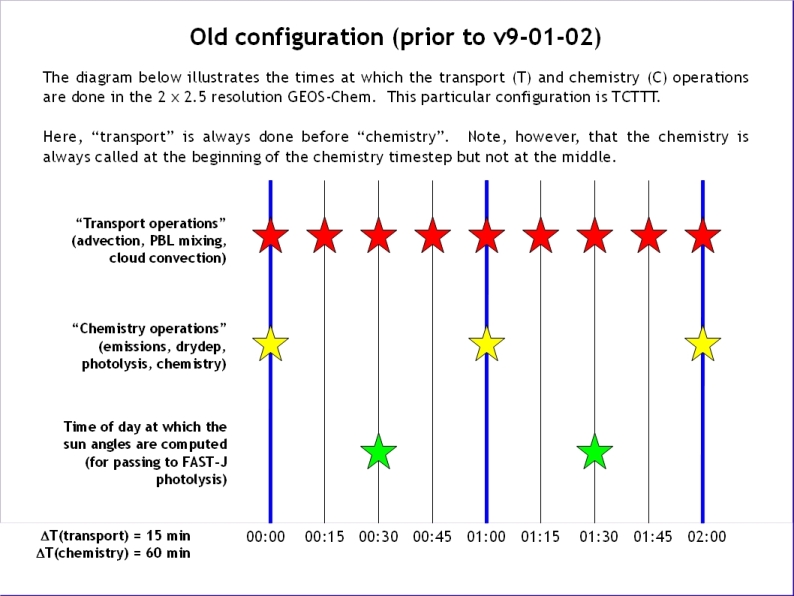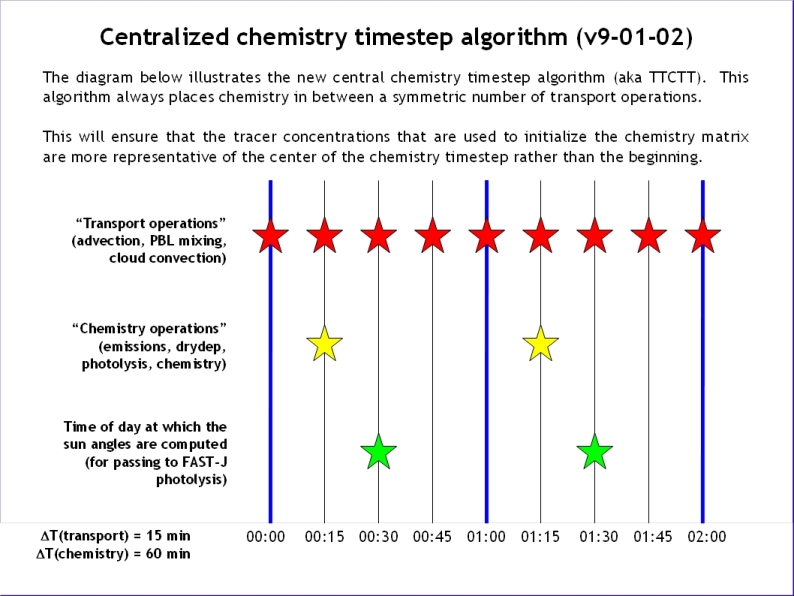Difference between revisions of "Centralized chemistry time step"
(→Overview) |
(→Overview) |
||
| Line 5: | Line 5: | ||
== Overview == | == Overview == | ||
| − | By "transport | + | By "transport" we mean the following dynamical operations: |
| − | + | * Advection | |
| − | + | * PBL mixing | |
| − | + | * Convection | |
| − | By "chemistry | + | By "chemistry", we mean the solving of the chemical mechanism matrix, plus the related operations that are used to compute reaction rates, i.e. |
| − | + | * Emissions | |
| − | + | * Dry deposition | |
| − | + | * Photolysis | |
| − | + | * Chemistry | |
| − | + | The "chemistry" time step ΔT(chemistry) is done must be a multiple of the "transport" time step ΔT(transport). Typically in GEOS-Chem: | |
| + | * ΔT(transport) is a function of the grid resolution | ||
| + | * ΔT(chemistry) has historically been 60 minutes. (This may not always be the optimal setting). | ||
| − | + | Currently, in the GEOS-Chem <tt>main.F</tt> driver program, "transport" is done before chemistry. This is due to historical usage. This order may be changed in the future; however we need to make sure that by doing so we do not break the current functionality. | |
| − | + | Also, we must keep in mind that the state of the atmosphere (i.e. advected tracer concentrations) are used to initialize the "chemistry" operations as follows: | |
| − | + | ||
| − | + | ||
| − | + | ||
| − | + | ||
| − | + | ||
| − | + | ||
| − | + | ||
| − | + | ||
| − | + | ||
| − | + | ||
| − | + | ||
| − | + | ||
| − | + | ||
| − | + | ||
| − | + | ||
| − | + | * Gas-phase tracer concentrations are fed into the reaction matrix | |
| + | * Aerosol optical depths are computed from the aerosol tracer concentrations and fed into the [[Photolysis mechanism]]. | ||
| + | |||
| + | GEOS-Chem currently computes the photolysis with the sun angles at the center of the "chemistry" timestep. This being the case, we should also make sure that the state of the atmosphere that is used to initialize the "chemistry" should be close to the center of the "chemistry" timestep. | ||
| + | |||
| + | However, in GEOS-Chem versions prior to [[GEOS-Chem v9-01-02]], this was not the case. "Chemistry" was always done at the beginning of the chemistry timestep (i.e. typically at the top of the hour). The following diagram illustrates this: | ||
| + | |||
| + | [[Image:Tcttt_configuration.jpg]] | ||
| + | |||
| + | hello | ||
| + | |||
| + | [[Image:Ttctt_configuration.jpg]] | ||
| + | |||
| + | regardless of model resolution. Therefore, we had these configurations for 4° x 5° and 2° x 2.5° resolution simulations: | ||
As you can see, the "chemistry operation" is not placed after a symmetric number of chemistry calls. | As you can see, the "chemistry operation" is not placed after a symmetric number of chemistry calls. | ||
| − | More text to be added | + | More text to be added= |
--[[User:Bmy|Bob Y.]] 16:55, 7 October 2011 (EDT) | --[[User:Bmy|Bob Y.]] 16:55, 7 October 2011 (EDT) | ||
| − | |||
| − | |||
| − | |||
| − | |||
| − | |||
| − | |||
| − | |||
| − | |||
| − | |||
| − | |||
| − | |||
| − | |||
| − | |||
Fix: (provided by Lin Zhang) | Fix: (provided by Lin Zhang) | ||
Revision as of 17:24, 20 October 2011
NOTE: Page under construction
On this page we provide information about the modification made to GEOS-Chem v9-01-02 which moves the time at which the chemistry, emissions, photolysis, and drydep operations are performed.
Contents
Overview
By "transport" we mean the following dynamical operations:
- Advection
- PBL mixing
- Convection
By "chemistry", we mean the solving of the chemical mechanism matrix, plus the related operations that are used to compute reaction rates, i.e.
- Emissions
- Dry deposition
- Photolysis
- Chemistry
The "chemistry" time step ΔT(chemistry) is done must be a multiple of the "transport" time step ΔT(transport). Typically in GEOS-Chem:
- ΔT(transport) is a function of the grid resolution
- ΔT(chemistry) has historically been 60 minutes. (This may not always be the optimal setting).
Currently, in the GEOS-Chem main.F driver program, "transport" is done before chemistry. This is due to historical usage. This order may be changed in the future; however we need to make sure that by doing so we do not break the current functionality.
Also, we must keep in mind that the state of the atmosphere (i.e. advected tracer concentrations) are used to initialize the "chemistry" operations as follows:
- Gas-phase tracer concentrations are fed into the reaction matrix
- Aerosol optical depths are computed from the aerosol tracer concentrations and fed into the Photolysis mechanism.
GEOS-Chem currently computes the photolysis with the sun angles at the center of the "chemistry" timestep. This being the case, we should also make sure that the state of the atmosphere that is used to initialize the "chemistry" should be close to the center of the "chemistry" timestep.
However, in GEOS-Chem versions prior to GEOS-Chem v9-01-02, this was not the case. "Chemistry" was always done at the beginning of the chemistry timestep (i.e. typically at the top of the hour). The following diagram illustrates this:
hello
regardless of model resolution. Therefore, we had these configurations for 4° x 5° and 2° x 2.5° resolution simulations:
As you can see, the "chemistry operation" is not placed after a symmetric number of chemistry calls.
More text to be added=
--Bob Y. 16:55, 7 October 2011 (EDT)
Fix: (provided by Lin Zhang) In time_mod.f, change this line
FLAG = ( MOD( ELAPSED_MIN, TS_CHEM ) == 0 )
to
! changes for proper chemistry time (lzh, ccc, 03/20/2010)
INTEGER :: M
!=================================================================
! ITS_TIME_FOR_CHEM begins here!
!=================================================================
! Get multiplier between transport and chemistry:
M = TS_CHEM/TS_DYN
! Divide by 2 (get middle). KEEP INTEGERS!!!!
M = MAX( M/2, 1 )
! Is it time for chemistry?
!FLAG = ( MOD( ELAPSED_MIN, TS_CHEM ) == 0 )
FLAG = ( MOD( ELAPSED_MIN, TS_CHEM ) == (M-1)*TS_DYN )
! Might be M+1 or M didn't think it through completely. And we may want
! to calculate M only once, so put it as a module variable
! (and change the name)
In this way, chemistry time step is put in the center of transport time steps.
Problem when calling planeflight diagnostics
This code caused the model to crash when you call planeflight diagnostics.
Because originally in main.f, TS_DYN=15min TS_CHEM=60min TS_DIAG=60min TCTTT(T is transport, C is chemistry) ITS_TIME_FOR_DYN()-->FLAG = ( MOD( ELAPSED_MIN, TS_DYN ) == 0 )--> Do dynamics ITS_TIME_FOR_CHEM()-->FLAG = ( MOD( ELAPSED_MIN, TS_CHEM ) == 0 )--> Do chemistry (call setup_planeflight based on ITS_A_NEW_DAY in chemdr.f) CALL TIMESTAMP_DIAG CALL SET_ELAPSED_MIN-->ELAPSED_MIN = ELAPSED_MIN + TS_DYN--> after this is done, it is not a new day any more. CALL SET_CURRENT_TIME ITS_TIME_FOR_DIAG() -->FLAG = ( MOD( ELAPSED_MIN, TS_DIAG ) == 0 )-->including call Planeflight.
Since we move chemistry time step to the middle of transport, TTCTT, chemdr.f won't call setup_planeflight anymore. So the model will crash when it calls planeflight during diag output (no initialization).
Fix provided by Bob Y.
replace these lines in chemdr.f
IF ( ND40 > 0 .and. ITS_A_NEW_DAY() ) THEN CALL SETUP_PLANEFLIGHT ENDIF
with:
INTEGER :: DATE
INTEGER, SAVE :: DATE_PREV = -1
................
!=================================================================
! At the beginning of each new day, call SETUP_PLANEFLIGHT
! to see if there are any plane flight points to be processed
!=================================================================
! Get todays' date
DATE = GET_NYMD()
! If this is the first chem timestep of a new day, then we need to
! call SETUP_PLANEFLIGHT. If chemistry is turned on, then we need
! to place this call here, so as to make sure that the chemical
! mechanism files (read by READER and READCHEM) have been loaded.
IF ( ND40 .and. DATE /= DATE_PREV ) THEN
print*, '### Called SETUP_PLANEFLIGHT'
CALL SETUP_PLANEFLIGHT
DATE_PREV = DATE
ENDIF
The idea is that you want to call SETUP_PLANEFLIGHT on the first chemical timestep of a new day. However, this is no longer just when NHMS == 000000. A better way to test that just to see when the date is not the same as the previous date.
--Jmao 14:17, 14 June 2011 (EDT)
Small fix for chemistry time step
Lin Zhang provided the following fix. In GeosCore/diag_pl_mod.f, change line 1021
IF ( MOD( HOUR + CHEM, 24d0 ) == 0 ) THEN
to
IF ( HOUR + CHEM .GE. 24d0 ) THEN
--Melissa Payer 14:36, 27 September 2011 (EDT)

